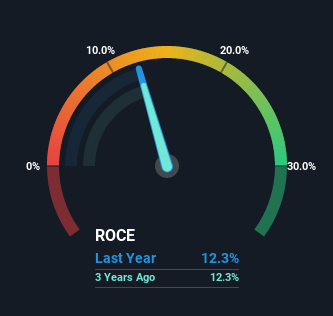- India
- /
- Electrical
- /
- NSEI:SCHNEIDER
Returns At Schneider Electric Infrastructure (NSE:SCHNEIDER) Appear To Be Weighed Down
What trends should we look for it we want to identify stocks that can multiply in value over the long term? Firstly, we'll want to see a proven return on capital employed (ROCE) that is increasing, and secondly, an expanding base of capital employed. If you see this, it typically means it's a company with a great business model and plenty of profitable reinvestment opportunities. That's why when we briefly looked at Schneider Electric Infrastructure's (NSE:SCHNEIDER) ROCE trend, we were pretty happy with what we saw.
Return On Capital Employed (ROCE): What is it?
For those that aren't sure what ROCE is, it measures the amount of pre-tax profits a company can generate from the capital employed in its business. Analysts use this formula to calculate it for Schneider Electric Infrastructure:
Return on Capital Employed = Earnings Before Interest and Tax (EBIT) ÷ (Total Assets - Current Liabilities)
0.12 = ₹491m ÷ (₹12b - ₹8.1b) (Based on the trailing twelve months to December 2021).
Therefore, Schneider Electric Infrastructure has an ROCE of 12%. That's a relatively normal return on capital, and it's around the 13% generated by the Electrical industry.
See our latest analysis for Schneider Electric Infrastructure

While the past is not representative of the future, it can be helpful to know how a company has performed historically, which is why we have this chart above. If you'd like to look at how Schneider Electric Infrastructure has performed in the past in other metrics, you can view this free graph of past earnings, revenue and cash flow.
What Can We Tell From Schneider Electric Infrastructure's ROCE Trend?
While the returns on capital are good, they haven't moved much. Over the past five years, ROCE has remained relatively flat at around 12% and the business has deployed 28% more capital into its operations. Since 12% is a moderate ROCE though, it's good to see a business can continue to reinvest at these decent rates of return. Stable returns in this ballpark can be unexciting, but if they can be maintained over the long run, they often provide nice rewards to shareholders.
On a side note, Schneider Electric Infrastructure has done well to reduce current liabilities to 67% of total assets over the last five years. Effectively suppliers now fund less of the business, which can lower some elements of risk. We'd like to see this trend continue though because as it stands today, thats still a pretty high level.
The Bottom Line
To sum it up, Schneider Electric Infrastructure has simply been reinvesting capital steadily, at those decent rates of return. Yet over the last five years the stock has declined 17%, so the decline might provide an opening. That's why we think it'd be worthwhile to look further into this stock given the fundamentals are appealing.
One final note, you should learn about the 3 warning signs we've spotted with Schneider Electric Infrastructure (including 2 which don't sit too well with us) .
For those who like to invest in solid companies, check out this free list of companies with solid balance sheets and high returns on equity.
New: Manage All Your Stock Portfolios in One Place
We've created the ultimate portfolio companion for stock investors, and it's free.
• Connect an unlimited number of Portfolios and see your total in one currency
• Be alerted to new Warning Signs or Risks via email or mobile
• Track the Fair Value of your stocks
Have feedback on this article? Concerned about the content? Get in touch with us directly. Alternatively, email editorial-team (at) simplywallst.com.
This article by Simply Wall St is general in nature. We provide commentary based on historical data and analyst forecasts only using an unbiased methodology and our articles are not intended to be financial advice. It does not constitute a recommendation to buy or sell any stock, and does not take account of your objectives, or your financial situation. We aim to bring you long-term focused analysis driven by fundamental data. Note that our analysis may not factor in the latest price-sensitive company announcements or qualitative material. Simply Wall St has no position in any stocks mentioned.
About NSEI:SCHNEIDER
Schneider Electric Infrastructure
Designs, manufactures, builds, and services products and systems for electricity distribution in India and internationally.
Solid track record with excellent balance sheet.
Similar Companies
Market Insights
Community Narratives





